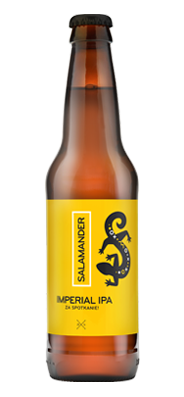Style
The style is stronger than AIPA in every respect: more extract, more alcohol, and, most importantly, more hops! Lower body than one might expect from such extract; lower maltiness, and light grist highlight the leading role that hops play in Imperial IPA.
We used an abundance of the best American hop varieties to achieve the bitterness, aroma, and hopping at the stage of separating hot deposits and the aging process in tanks. The produced effect are overwhelming fruity, resinous and hoppy tones.
Malts/extract:
As the name suggests, Imperial IPA is one of the most powerful beers. The numbers speak for themselves. The 19% extract means that it is a beer to be cherished at slightly colder nights. To top off the high initial extract, maltiness works as the background for the beer’s gigantic level of hoppiness. It’s the reason why the grist was made of light malts only. A small percent of sugar added increases the beer’s dryness and gives the floor to new-wave hops.
Hops:
Imperial IPA requires hops to be filled to the very brim. While brewing this style, the equipment’s capacities are often used to the maximum: hop jacks break down and installations get stuck with hops. Such intense hopping allows for the necessary bitterness to balance the beer’s power. And yet, the one thing Imperial IPA is known for is its hoppy aroma. We’ve used mostly new-wave hop varieties that have recently been used only as experimental hops.
Calypso (until recently known as Hopsteiner Experimental Hop #03129) is an exceptionally fruity variety with a dominant tone of green pear enhanced by tropical fruit followed by apple and mint hints.
Eureka! (until recently known as Hopsteiner Experimental Hop #05256) on the other has a citrus profile with a touch of peach, pine, mandarin oranges, black currant, and a herbal finish.
Serving:
The narrowing rim of Tulip, Sensoric or IPA glasses allow for the hoppy character of the beer to show best. It’s a good idea for the beer to warm up in order to release aromas not produced in Lower temperatures. This style is always best fresh as hoppy aromas may at times lose their intensity.
Food pairing:
Taking into account its intensity, it is a challenge to suggest food pairing for Imperial IPA. Most dishes are dominated by such a powerful beer. Here is the general rule. Dishes that pair with American IPA should also match its fortified version on one condition: the food should be spiced up even more. Bitterness enhances salty and umami tastes, which, on the other hand, balance bitter flavours. Hoppy beers are a great match for oriental cuisine. Here is a perfect dish: steamed roll filled with crispy vegetables and shredded beef in a slightly stronger BBQ sauce.
As for cheeses, choose the sharp ones such as the strongest varieties of Roquefort. Their spiciness will be enriched by the bitterness of Imperial IPA.
Hardly do we offer desserts with Imperial IPA, but if you decide to do so, go for the more distinctive ones offering a wide range of flavours. Another interesting choice would be a ricotta cheesecake with ginger pastry coated with salty dulce de leche. Just to make desserts a bit lighter, add a layer of sourish fruit such as black berry mousse.
- Style: Imperial India Pale Ale
- Parameters
- Extract: 19,0 %
- Alcohol: 8,5 %
- IBU: 90
- Ingredients:
- Malts: barley malts: Pilsner; carahell, wheat
- Hops: bitter: Columbus (US) /aromatic: Eureka! (US), Mandarina Bavaria (DE) / hopping: Calypso, Eureka!, Citra, Cascade (US)
- Yeast: top fermentation; US-05
- Look: dark orange;
- Aromas: pineapple; citrus fruit; peach; pear; herbs; pine; mint;
- Flavour:
- full, smooth
- slightly bitter; resinous
- fruity; slightly stony
- Serving temperature: 12-15 ⁰C
- Glass: IPA Glass, Sensoric,
- Foodpairing:
Dishes: steamed roll filled with crispy vegetables and shredded beef in a stronger BBQ sauce with cane sugar; Jambalaya; Chile relleno
Cheeses: Stilton,
Desserts: ricotta cheesecake with ginger pastry coated with salty dulce de leche.



